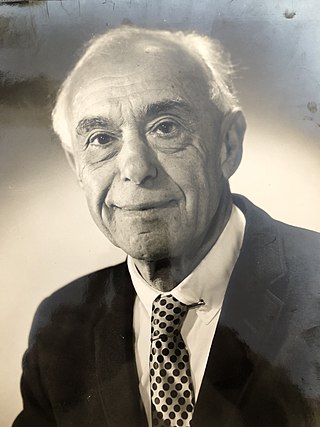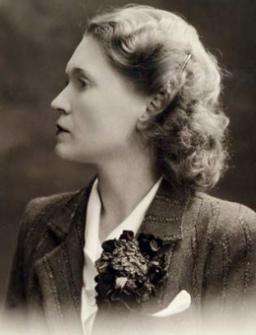
An antibiotic is a type of antimicrobial substance active against bacteria. It is the most important type of antibacterial agent for fighting bacterial infections, and antibiotic medications are widely used in the treatment and prevention of such infections. They may either kill or inhibit the growth of bacteria. A limited number of antibiotics also possess antiprotozoal activity. Antibiotics are not effective against viruses such as the ones which cause the common cold or influenza; drugs which inhibit growth of viruses are termed antiviral drugs or antivirals rather than antibiotics. They are also not effective against fungi; drugs which inhibit growth of fungi are called antifungal drugs.
This is the timeline of modern antimicrobial (anti-infective) therapy. The years show when a given drug was released onto the pharmaceutical market. This is not a timeline of the development of the antibiotics themselves.

Gerhard Johannes Paul Domagk was a German pathologist and bacteriologist.

Sulfonamide is a functional group that is the basis of several groups of drugs, which are called sulphonamides, sulfa drugs or sulpha drugs. The original antibacterial sulfonamides are synthetic (nonantibiotic) antimicrobial agents that contain the sulfonamide group. Some sulfonamides are also devoid of antibacterial activity, e.g., the anticonvulsant sultiame. The sulfonylureas and thiazide diuretics are newer drug groups based upon the antibacterial sulfonamides.
The year 1932 in science and technology involved some significant events, listed below.
The year 1935 in science and technology involved some significant events, listed below.

Dapsone, also known as 4,4'-sulfonyldianiline (SDA) or diaminodiphenyl sulfone (DDS), is an antibiotic commonly used in combination with rifampicin and clofazimine for the treatment of leprosy. It is a second-line medication for the treatment and prevention of pneumocystis pneumonia and for the prevention of toxoplasmosis in those who have poor immune function. Additionally, it has been used for acne, dermatitis herpetiformis, and various other skin conditions. Dapsone is available both topically and by mouth.

Sulfadiazine is an antibiotic. Used together with pyrimethamine, a dihydrofolate reductase inhibitor, it is the treatment of choice for toxoplasmosis, which is caused by a protozoan parasite. It is a second-line treatment for otitis media, prophylaxis of rheumatic fever, chancroid, chlamydia, and infections by Haemophilus influenzae. It is also used as adjunct therapy for chloroquine-resistant malaria and several forms of bacterial meningitis. It is taken by mouth. Sulfadiazine is available in multiple generic tablets of 500 mg. For urinary tract infections, the usual dose is 4 to 6 grams daily in 3 to 6 divided doses.

Sulfanilamide is a sulfonamide antibacterial drug. Chemically, it is an organic compound consisting of an aniline derivatized with a sulfonamide group. Powdered sulfanilamide was used by the Allies in World War II to reduce infection rates and contributed to a dramatic reduction in mortality rates compared to previous wars. Sulfanilamide is rarely if ever used systemically due to toxicity and because more effective sulfonamides are available for this purpose. Modern antibiotics have supplanted sulfanilamide on the battlefield; however, sulfanilamide remains in use today in the form of topical preparations, primarily for treatment of vaginal yeast infections such as vulvovaginitis caused by Candida albicans.

Sulfacetamide is a sulfonamide antibiotic.

Sulfadimethoxine is a long-lasting sulfonamide antimicrobial medication used in veterinary medicine. It is used to treat many infections, including respiratory, urinary tract, enteric, and soft tissue infections and can be given as a standalone or combined with ormetoprim to broaden the target range. Like all sulfamides, sulfadimethoxine inhibits bacterial synthesis of folic acid by acting as a competitive inhibitor against PABA. It is the most common drug prescribed to dogs who have coccidiosis.

Sulfapyridine is a sulfanilamide antibacterial medication. At one time, it was commonly referred to as M&B 693. Sulfapyridine is no longer prescribed for treatment of infections in humans. However, it may be used to treat linear IgA disease and has use in veterinary medicine. It is a good antibacterial drug, but its water solubility is very pH dependent. Thus there is a risk of crystallization within the bladder or urethra, which could lead to pain or blockage. As with other sulfonamides, there is a significant risk of agranulocytosis, and this, rather than the development of resistance by bacteria, is the main reason for its decline in use.

The Demon Under the Microscope: From Battlefield Hospitals to Nazi Labs, One Doctor's Heroic Search for the World's First Miracle Drug is a 2006 nonfiction book about the discovery of Prontosil, the first commercially available antibacterial antibiotic and sulfanilamide, the second commercial antibiotic. Prontosil was the first commercially available antibacterial antibiotic (with a relatively broad effect against Gram-positive cocci. It was developed in the 1930s by a research team at the Bayer Laboratories of the IG Farben conglomerate in Germany. The discovery and development of this first sulfonamide drug opened a new era in medicine.

In organic chemistry, the sulfonamide functional group is an organosulfur group with the structure R−S(=O)2−NR2. It consists of a sulfonyl group connected to an amine group. Relatively speaking this group is unreactive. Because of the rigidity of the functional group, sulfonamides are typically crystalline; for this reason, the formation of a sulfonamide is a classic method to convert an amine into a crystalline derivative which can be identified by its melting point. Many important drugs contain the sulfonamide group.
Eleanor Albert Bliss was an immunologist who made significant advancements to the field of immunological research. She was also a dean and professor of biology at Bryn Mawr College.
Jacques Tréfouël was a French medical chemist. He collaborated closely with his wife, Thérèse Tréfouël, including on the discovery of sulfanilamide.

Sanford Morris Rosenthal was born in Albany, Georgia.

Thérèse Tréfouël was a French chemist. Along with her husband, Jacques Tréfouël, she is best known for her research on sulfamides, a novel class of antibiotic drugs.
Wesley William Spink was an American physician, medical school professor, college coach, and medical researcher. He was "an internationally recognized authority on infectious diseases and is credited with controlling the spread of brucellosis ".
Paul Josef Jakob Gelmo was an Austrian chemist who worked on synthetic dyes and discovered sulfanilamide in 1908, although their antibiotic properties were discovered only in 1932.













